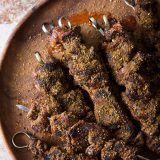Want a better beef skewer? Spice it twice.
It’s a lesson we learned in Beijing, where the aroma of spices sizzling against fat wafts from street stalls, filling the air. Typically made with lamb, but sometimes beef and chicken, these glistening skewers of cumin- and chili-coated meat are a common snack.
This bold flavor profile—often a blend of anisey fennel, earthy cumin and tingly Sichuan peppercorns—is traditional of yang rou chuan, the lamb skewers popularized by the predominantly Muslim Uyghur communities in China’s northwest Xinjiang Province. Today, chuan have become ubiquitous offerings at barbecue spots nationwide.
The secret to the meat’s delicious results isn’t only the combination of flavors. Just as important is how those spices are applied. And in this case, that means twice.
After skewering but before going on the grill, the meat is dusted generously with the spices. Those spices toast, their flavors deepening during cooking. Once the meat comes off the heat, it’s seasoned a second time with the same spice blend, creating multiple layers of nuanced flavors from the same few ingredients.
“The dish is now very popular all throughout China. It represents the various cultures that have contributed, over many years, to the fabric of what we call Chinese cuisine,” says Jason Wang, cookbook author and owner of New York’s Xi’an Famous Foods. “At night, my dad would take me to the Muslim Quarter. We would order skewers not by ones or twos, but by tens. That, to me, was the flavor of Xi’an,” he says.
Our take on chuan uses flat-iron steak—a well-marbled cut perfect for high-heat, high-speed grilling—but thinly sliced lamb shoulder or leg also work well. The salt from a soy sauce marinade helps season the meat from the get-go. We then pat the majority of the spice mixture (toasted and ground for deeper flavor and easier application) onto the meat before cooking, reserving some—true to tradition—for adding to the skewers after grilling.
Spicy Chinese Beef Skewers
A chili-spiked spice blend gives these beef skewers their vibrant flavor.
Photo: Connie Miller of CB Creatives; Styling: Catherine Smart




